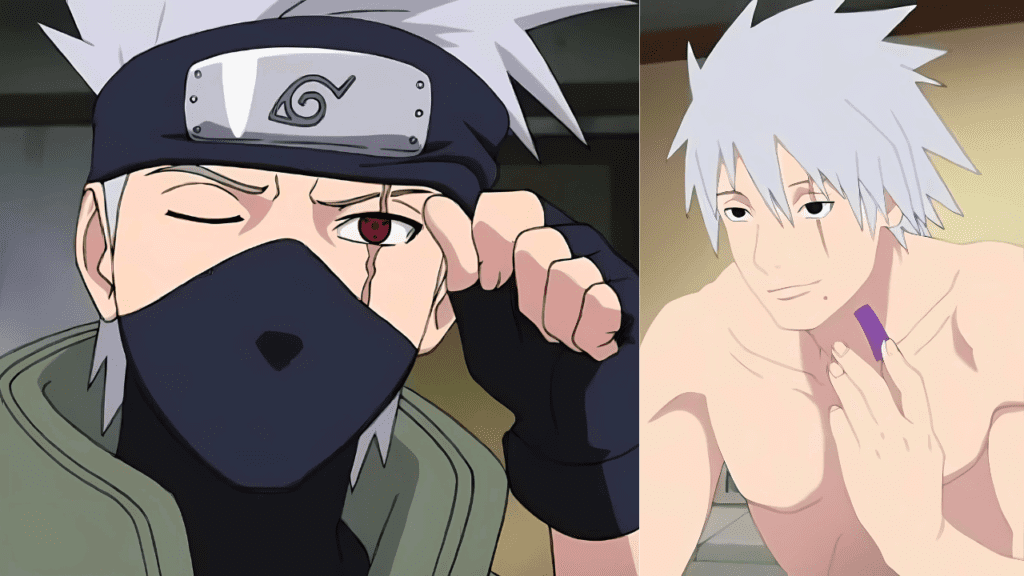
Kakashi Hatake, famously known as “The Copy Ninja” or “Kakashi Of The Sharingan” is one of the most beloved and iconic characters of Naruto. His legacy is one of immense complexity, weaving together tragedy, triumph, and leadership.
Throughout Naruto, Kakashi’s character evolves from a distant, mysterious figure into a compassionate mentor and revered hero. His journey is one of overcoming personal loss, finding meaning in teamwork, and shaping the next generation of ninjas.
Early Life and Tragedy

Kakashi, born into the prestigious Hatake Clan, son of Sakumo Hatake, famously known as “White Fang Of The Leaf”. Despite his father’s prowess, Sakumo’s reputation crumbled after he chose to abandon a mission to save his comrades, a decision that led to ridicule and disgrace. Unable to bear the shame, Sakumo took his own life when Kakashi was very young, leaving a deep emotional scar on the boy.
This tragedy shaped Kakashi’s early worldview. He became cold, distant, and strictly adhered to the rules of the ninja world, believing that his father’s failure came from prioritizing personal feelings over duty. Kakashi’s belief in following the rules without exception was challenged when he was assigned to Team Minato, led by Minato Namikaze (the future Fourth Hokage).
The Turning Point: Loss of Obito and Gaining the Sharingan

One of the most defining moments of Kakashi’s life occurred during a mission in the Third Great Ninja War. Tasked with destroying a bridge crucial to enemy forces, Kakashi was made team leader due to his skill and intelligence. However, tragedy struck when Obito Uchiha, his teammate and friend, was crushed under a boulder while saving Kakashi.
Obito’s sacrifice left a deep emotional impact on Kakashi, marking the first time he realized the importance of protecting his comrades over following strict rules. Obito gave Kakashi his left Sharingan eye as a last gift. This event, known as the “Kanabi Bridge incident,” forever changed Kakashi.
The weight of this loss haunted Kakashi for years, driving him into a state of emotional isolation. He even lost Rin Nohara shortly after, an event that deepened his trauma and guilt, as she was killed by his own hands.
Mentor to Team 7: Teaching a New Generation

Kakashi’s assignment as the leader of Team 7, which included Naruto Uzumaki, Sasuke Uchiha, and Sakura Haruno, was a turning point in his life. Although initially detached and seemingly uninterested in his students, Kakashi’s interactions with Team 7 gradually brought him out of his emotional shell.
One of Kakashi’s most significant lessons to his students was the phrase: “Those who break the rules are scum, but those who abandon their comrades are worse than scum.” This shift in his ideology represented his personal growth and the realization which came after the loss of his best friend Obito Uchiha.
Kakashi’s mentorship also played a pivotal role in the growth of his students, particularly Naruto and Sasuke. Despite Sasuke’s eventual defection from the village, Kakashi never gave up hope for his former student, reflecting his deep commitment to those he cared about.
War Hero and Hokage

Kakashi fought alongside Naruto and the Allied Shinobi Forces against powerful enemies like Obito Uchiha (his former friend), Madara Uchiha, and ultimately Kaguya Otsutsuki. His tactical mind, leadership, and combat prowess were crucial in these battles.
After the war, Kakashi was chosen to become the Sixth Hokage of the Hidden Leaf Village, cementing his legacy as one of the village’s greatest leaders. Though he initially expressed reluctance, his time as Hokage was marked by peace and rebuilding after the devastation of the war.
Legacy of the Copy Ninja

Kakashi Hatake’s legacy is multifaceted. He is remembered as the “Copy Ninja” who could replicate over a thousand jutsu, as a mentor who shaped the future of powerful ninjas like Naruto and Sasuke, and as a leader who guided the village through turbulent times.
Kakashi’s influence reaches far beyond his abilities as a ninja. In the end, Kakashi’s legacy is not just about his strength as a fighter, but his growth as a person, a journey of healing, self-acceptance, and the understanding that true strength comes from the bonds we share with others.

1 thought on “The Inspiring Legacy of Kakashi Hatake: The Rise of the Copy Ninja”